Henschel Hs-126 - "annoying crutch" in the service of the Luftwaffe
In the autumn of 1936, the first prototype of the Hs-126 took off, several pre-production copies were launched in 1937, and from January 1938 to January 1941 this aircraft was mass-produced at the Henschel-Werke plant, as well as at the AGO Flugzeugwerke enterprise. The Hs-126 was a double all-metal strut monoplane with non-retractable landing gear closed by fairing.
The purpose of creating this machine was to provide the Luftwaffe with a kind of universal aircraft to perform combat and non-combat functions. The main purpose of the Hs-126 was considered the role of a short-range reconnaissance and spotter, and, in fact, it was a new incarnation of the traditional observer aircraft already for the First World War. In order to create an excellent downward view, the wing was raised high above the level of the cockpit, and the cockpit itself was designed specifically for ease of observation. The aircraft as a whole was considered reliable and convenient for pilots (the same cockpit had glazing), easy to operate (in particular, flaps and ailerons were hydraulically boosted), and, most importantly, was able to operate from almost any runway (which was necessary for use as a communications aircraft).
It must be said that the Henschel company initially did not receive a state order for its production, and in 1937-1938 the aircraft was considered a civilian model, only in 1939 moving into the category of military vehicles. All of the above led to the weak armament of the Hs-126, which consisted of only two 7,92-mm machine guns: a fixed MG-17 in front of the pilot (ammunition 500 rounds) and an MG-15 at the back of the observer on a mobile installation (ammunition 975 rounds). . And although this aircraft developed, in general, a good speed in its class and for that time - up to 300-320 km / h, it had a short radius of action and could carry no more than 100 kg of bomb cargo (10 by 10 kg or 2 by 50 kg).
After the adoption of this aircraft, the production of two modifications of the Hs-126A and Hs-126 B with more powerful engines (Bramo "Fafnir" and BMW-323, both 850 hp each) and with a variable pitch propeller was launched, which made it possible to increase speed up to 350-370 km/h. In addition, all military models of these aircraft were equipped with FuG-17 radios, which was necessary for the rapid transmission of reconnaissance and artillery correction data, as well as two cameras - a stationary one built into the fuselage, and a manual one used by an observer. Also, purely military modifications of the Hs-126 could carry a slightly larger load of bombs - up to 150 kg (1 x 50 kg and 10 x 10 kg), and armored backs (from 8 mm armor) were installed for the pilot and observer.
New modifications of the machine in question were produced only a year, from January 1940 to January 1941, but during this period 368 units were produced, whereas for the entire production time, 810 units to 913 units were assembled, which is quite a large number (of which AGO 430-483 unit.).
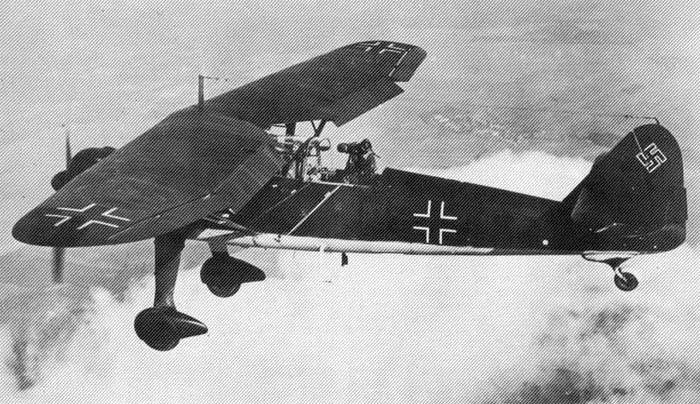
The release of this, it must be said, little suitable for modern warfare even then in such a large number of aircraft, is rather difficult to explain (except as a corruption component or the action of hidden agents of influence). This fact looks especially strange against the background of a meager release (254 units) by the same Henschel company of such efficient, hard-to-kill and purely military-purpose vehicles as the Hs-123 (about which material has already been posted on Military Review).
Of course, we can say that factories produce what they can, but the situation looks very intriguing when the repeated requests of Wehrmacht and Luftwaffe officers to resume the production of vehicles of this type for the needs of the Eastern Front are rejected under various pretexts, and they continue to be delivered to combat units, in general , ineffective in combat and vulnerable Hs-126. In the Soviet Union of that time, such behavior was characterized by the definition of "sabotage", and entailed appropriate sanctions. And although the idea of the “sabotage” activity of the Henschel concern in relation to the Third Reich is new to the Russian reader, the available facts allow us to assert this quite reasonably. Moreover, this was not some kind of fictitious "sabotage", which became the basis for many fabricated cases in the USSR, but a process of production of inefficient or unnecessarily difficult weapons to produce by a group of people.
The first combat use of several Hs-126s took place in Spain, where they were used as tactical reconnaissance and short-range bombers in the "Ausfklarungsgruppe 35", and where they received the code name "Super Pavo". They arrived there towards the end of the war, were not used in the conditions of enemy air supremacy and proved to be successful, although one machine was lost.
In the pre-war period, Henschel began actively exporting its “dual-use items” abroad: from 16 to 32, Hs-126 was sold to Greece, a few dozen to Bulgaria, Croatia and Estonia. In connection with the sale of the party Hs-126 to Greece, a funny episode happened, well illustrating the relationship between industrial capital and government bodies in the Third Reich.
The Greek government became interested in this versatile aircraft and signed a contract for the supply of 32 machines. The Henschel firm was already ready to send the first batch of 16 aircraft, but the Nazi government blocked the delivery of "dual-use equipment to a state that is not our ally." In response, the Henschel concern protested this decision, referring to the execution of the contract, and as a result, the parties came to a compromise: Berlin allowed the delivery, but forbade equipping the aircraft with weapons and communications equipment. In general, it is somehow difficult even to imagine that in the Stalinist USSR, for example, any aircraft factory on its own in 1939 would sell its combat aircraft to, say, Finland; The Kremlin forbids doing this; the concern protests this decision and executes the delivery, simply not putting weapons on the aircraft (analogues of which the buyer easily installs on his own upon receipt of the machines). Thus, the above example shows quite clearly that the Nazi government had to take into account the interests of industrial capital, and industrial concerns had a fairly large freedom of action and could influence government decisions.
Ironically, soon the Greek "Henschels" as light bombers and reconnaissance aircraft acted against the Italian (autumn-winter 1940) and against the German troops (spring 1941), and the Bulgarian, Croatian and German Hs-126 fought against the Greek forces. This once again suggests that in the leadership of the Henschel concern (by the way, it successfully survived the war and still exists today), not everyone sympathized with the Nazis, and this industrial association pursued at least an ambiguous policy under the Nazi regime.
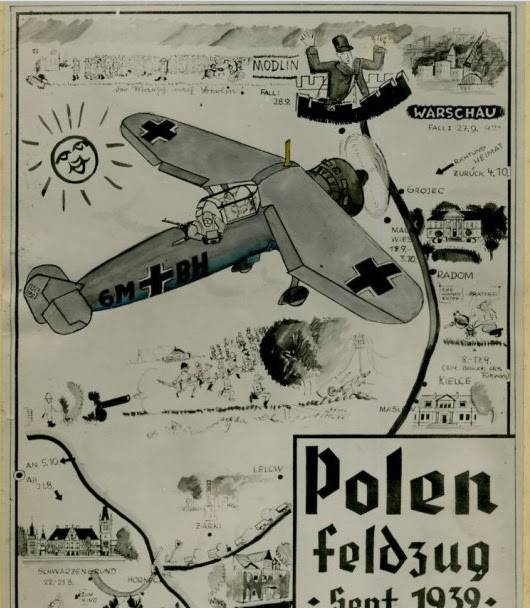
In Germany itself, by the beginning of World War II (on 01.09.1939), the Hs-126 was the backbone of the reconnaissance units of the Luftwaffe - the 29 squadrons of this model were armed with 23 (267 Hs-126 were in combat units, of which 234 were combat-ready). However, starting from the Polish campaign, these relatively low-speed and, in general, vulnerable aircraft sustained heavy losses (on average, up to 30% of the number of units involved). So, in the skies over Poland, 25 Hs-126 was lost, including 16 was shot down by fighters, and 40 machines of this type were heavily damaged.
The fate of the small lot in 7 Hs-126, which were sold to Estonia, is unknown exactly. After Estonia became part of the USSR, these vehicles were transferred to the 22 of the territorial rifle corps of the Red Army, and, apparently, were partially destroyed when the German aircraft struck at their home base, and were partially shot down in the air.
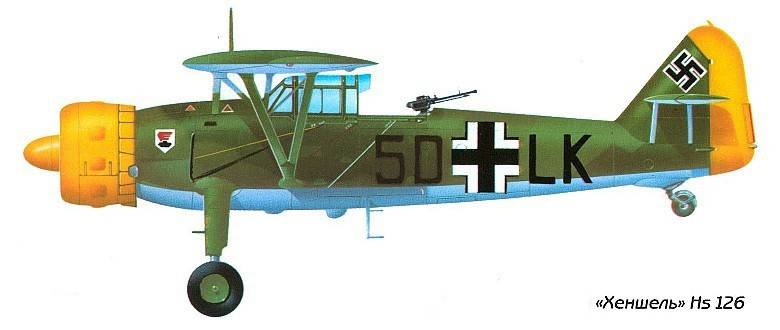
After participating in campaigns against France and in the Balkans, most of the tactical reconnaissance squadrons armed with the Hs-126 took part in Operation Barbarossa, and one squadron was transferred to North Africa with E. Rommel's corps. In total, on 01.06.1941/602/126, the Luftwaffe, including flight schools and rear units, included 1941 Hs-01.03.1942. However, due to their high vulnerability, since the summer of 35, these aircraft have been gradually withdrawn from combat units, reorienting themselves to solving auxiliary tasks. True, this was a gradual process - since as early as 16/126/126 on the Eastern Front, out of 1941 short-range reconnaissance units, XNUMX were still flying Hs-XNUMX. Thus, one should not assume that the Luftwaffe forces that attacked the USSR consisted entirely of aircraft of the most modern types; there were many obsolete vehicles among them, and, for example, the Hs-XNUMX became one of those models of equipment that the Germans were forced to withdraw from the front line already starting in XNUMX.
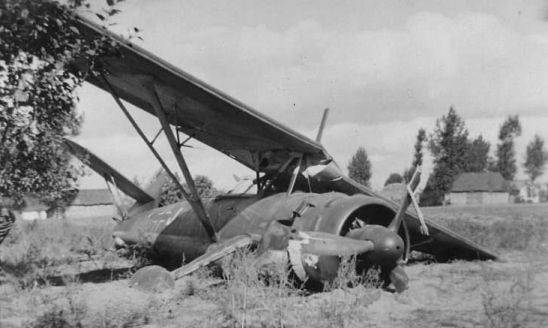
To show the level of losses that these aircraft suffered on the Soviet-German front, let's say that in just 1 day - 22.06.1941/13/126 - 1941 Hs-381s were shot down and several dozen damaged, and in December 1941 the number of lost aircraft of this type increased to 126 units Already from the end of the summer of 1, 2-109 Bf-4s were necessarily allocated to escort the Hs-126. Later, the number of escort fighters reached a whole link of XNUMX vehicles, but this also did not work - these slow-moving vehicles one way or another became a "bait" for Soviet fighters, even outdated brands, and escort fighters often used the current situation not to protect their reconnaissance at any cost , but to build up a personal score of victories (despite the fact that the vulnerable Hs-XNUMX was often shot down too).
From the autumn of 1941 and, especially, from the spring-summer of 1942, their functions as scouts were transferred to the Fw-189 everywhere, and the Henschels remaining on the Eastern Front were gradually transferred to night light bomber aviation units or to flight schools. Yes, yes, following the example of the Air Force of the Red Army Luftwaffe on the Eastern Front, squadrons of light night bombers were created from obsolete types of aircraft, the use of which during the day was associated with high losses. As you can see, the Germans did not shy away from borrowing useful tactical novelties from the enemy.
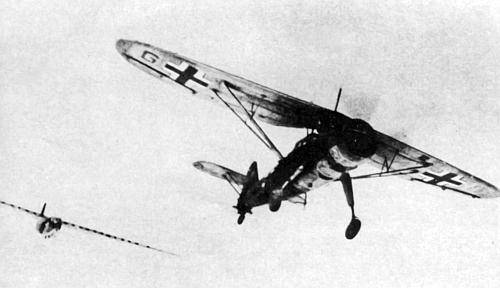
Note that these aircraft played an important role during the air supply operation for the encircled German group near the city of Kholm, which took place from January 21 to May 5, 1942. This was the first and successfully completed operation of this kind for the Wehrmacht on the Eastern Front (and this will become along with other factors, one of the conditions for the formation of the Stalingrad pocket, when the Germans presumptuously decide that they will again be successfully supplied from the air). In the course of carrying out tasks to ensure the surrounded formations of the Wehrmacht, the Hs-126 not only took up to 200 kg of cargo, but was also used as a tug of small transport gliders.
On the Eastern Front 01.09.1942, it still remained in the 103 Hs-126 Luftwaffe combat units, mainly in the night light bomber units. Some of these machines were used from the fall of the 1942 to the spring of the 1943 as light supply aircraft and tugs of small cargo gliders.
However, perhaps the most famous operation in which the Hs-126 played an important role was already carried out when these slow aircraft were withdrawn from the front. We are talking about the famous raid of the German special forces, carried out on September 12, 1943 in order to release the arrested Benito Mussolini. It was these aircraft that reconnoitred the landing site and were used as tugs of transport gliders with Nazi soldiers who attacked a secluded villa where the Italian dictator was kept under arrest.
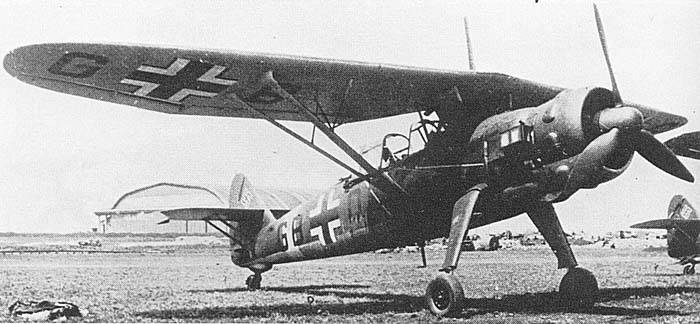
As of 01.03.1944/174/126, there were still 13 Hs-11s in the Luftwaffe, some of which were in service with the following combat squadrons on the Eastern Front: 2./NSGr-12 based in Estonia, 2./NSGr-7 based in Lithuania and 126./NSGr-XNUMX based in the Balkans. At that time, these aircraft were used at the front as night light bombers. Behind the front line, in the German rear, the Hs-XNUMX was used as day light bombers and reconnaissance aircraft to fight partisans, as well as communications aircraft, in which role they served until the end of the war.
Summing up, we can say that the Hs-126, although it firmly occupied its niche in the initial period of World War II, was easy to manufacture, reliable and maintainable, but in general it did not represent anything outstanding, and already in 1942 it was launched for supporting roles. However, in the period from the summer of 1941 to the autumn of 1942, as a tactical reconnaissance and artillery spotter, he still managed to earn his unpleasant nickname from our soldiers, and then for another two years the Henschels disturbed the Soviet formations at night and harmed the partisans.
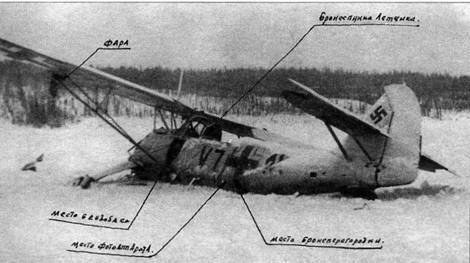
It can be said that the adoption of the Hs-126 by the Luftwaffe was some forced and relatively unsuccessful attempt to use a dual-purpose aircraft (before the famous Fw-189 appeared in sufficient numbers). But one way or another, the advanced units of the Wehrmacht at the initial stage of World War II had these nimble tactical scouts in front of them, informing their commanders about the enemy and coordinating the fire of German artillery and the actions of attack aircraft. True, these were rather slow-moving and vulnerable vehicles, which the ground units of the enemy tried to shoot down in the first place, and, unlike the invulnerable Fw-189, this was usually quite easy to do.
Several copies of the Hs-126 of varying degrees of preservation have reached our time, including at least one flying model, sometimes used for air shows in the UK. Despite the fact that the absolute majority of Hs-126 was shot down over the territory of the former USSR, in our country, unfortunately, not a single more or less of a whole copy of this aircraft remained.
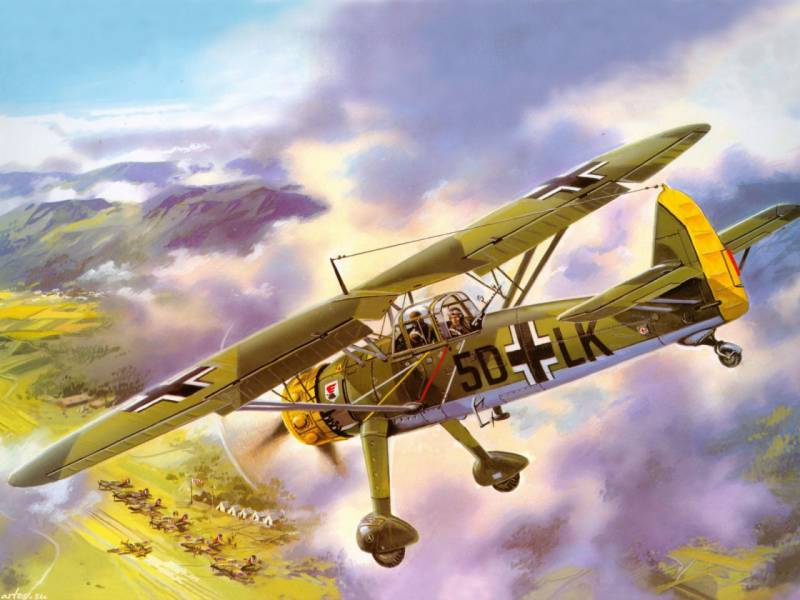
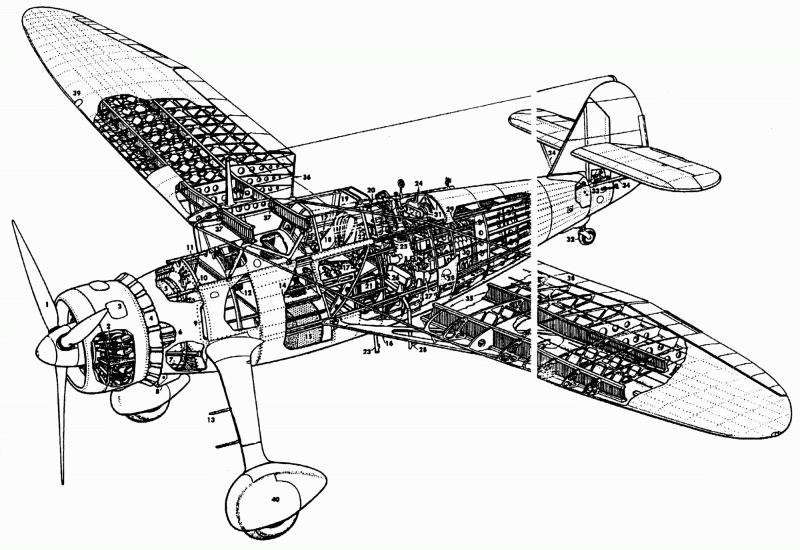
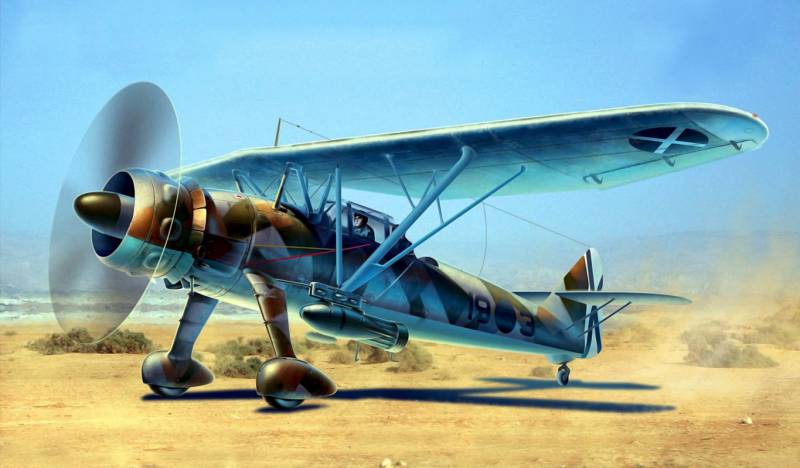
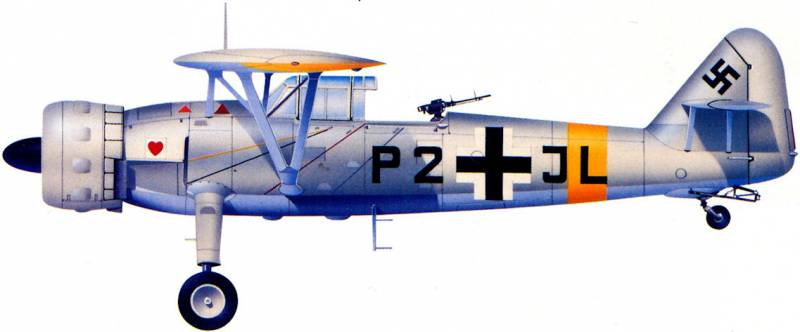
Information